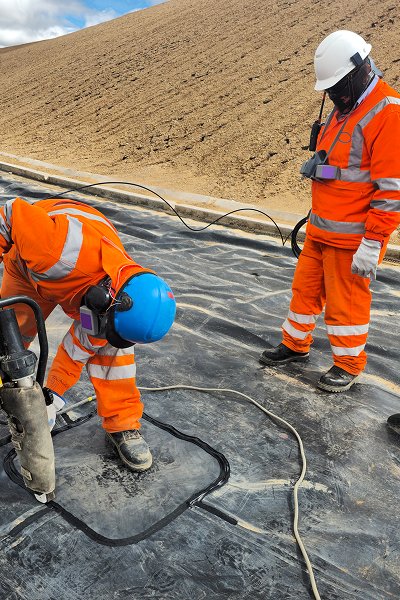What are geobags?
Geobags are based on high-strength, corrosion-resistant and aging-resistant geosynthetics (mainly geotextiles), sewn into bags of a certain size and shape. They are often used to fill sand or other solid materials to achieve structural reinforcement, slope stabilization, water conservancy protection and other purposes.

Main raw materials of geobags
The performance and applicability of geobags depend on the geotextile materials used. At present, the main materials include:
Polypropylene (PP)
Features: light weight, high strength, chemical corrosion resistance, UV resistance.
Advantages:
Excellent tensile strength and impact resistance
Strong corrosion resistance, can be used in acid, alkali and salt environments
Low water absorption, suitable for water conservancy and coastal projects
Features: high strength, good stability, better thermal stability than PP.
Advantages:
High tensile strength
Good high temperature resistance (melting point about 260℃)
Not easy to degrade when buried in the soil for a long time, suitable for long-term projects
Features of geobags
High strength and durability; geobags are usually made of high molecular synthetic fiber materials such as polypropylene (PP) and polyester (PET), with excellent tensile strength, tear strength and puncture resistance, and can withstand the weight of the filling material and external environmental pressure, suitable for reinforcement projects with high strength requirements.
Good water permeability; non-woven geobags have good water permeability, which can effectively remove internal water accumulation and reduce the pore water pressure of the soil, which is conducive to maintaining the stability of the slope or foundation structure.
Strong chemical corrosion and UV resistance; geobag materials can withstand a variety of chemical media (such as acids, alkalis and salts), and have strong UV resistance, suitable for coastal, wetland, landfill and other projects with corrosive or exposed environments.
Convenient construction, economical and efficient; geobags are easy to transport, and can be used by filling local sand on site, without the need for large-scale machinery and equipment, significantly reducing construction costs and construction periods, suitable for emergency rescue and field operations.
Various shapes and strong adaptability; according to different engineering requirements, bags of various sizes and shapes can be customized, such as rectangular, cylindrical, with connecting belts, etc. Suitable for various terrains and working conditions, such as dams, slopes, foundations, embankment foot, etc.
Application areas
River regulation and embankment reinforcement
River regulation and water conservancy revetment are one of the earliest and most mature application areas of geobags. Laying geobags filled with sand on the river slope or the outer slope of the embankment can play the following roles:
Strengthen the stability of the embankment foundation and prevent water erosion
Build a flexible protective structure to adapt to water level changes
Use as temporary or permanent cofferdam and embankment materials
Use as flood control sandbags in emergency rescue projects

Slope protection and ecological restoration
Exposed slopes are prone to soil erosion and landslides in mountain roads, high-speed railways or reservoir slopes. Geobags mainly play the following roles in such projects:
Anti-scouring, anti-slip, and maintaining slope stability
Using the porosity and rough surface of the bag to promote vegetation growth
Achieve the dual goals of "structural protection + ecological greening"

Foundation reinforcement and ground treatment
In the soft foundation treatment and building foundation reinforcement projects, geobags can be arranged in a mesh or layered structure to provide reinforcement, restraint and drainage functions, including:
Pretreatment of soft soil foundation before filling to accelerate foundation consolidation
Reinforcement of the bottom support layer of structures such as landfills and dams
Stable structure of the roadbed reinforcement layer of highways and railways

As a new type of geosynthetics that combines structural, ecological and economic properties, geobags are playing an increasingly important role. From simple flood control sandbags to high-strength seawall components, ecological slope protection systems, and landfill closure materials, the application of geobags has been continuously expanded, the technical level has been continuously improved, and the material composition has become increasingly diversified and professional.
Comprehensive consideration is based on application scenarios, environmental conditions, service life and ecological needs. At the same time, the quality standards and testing specifications of the products also provide technical support for ensuring the safety of the project. Whether it is polypropylene, polyester fiber, or natural jute, coconut fiber and other environmentally friendly materials, its essential goal is always to bring more stable, greener and more economical solutions to the project.


